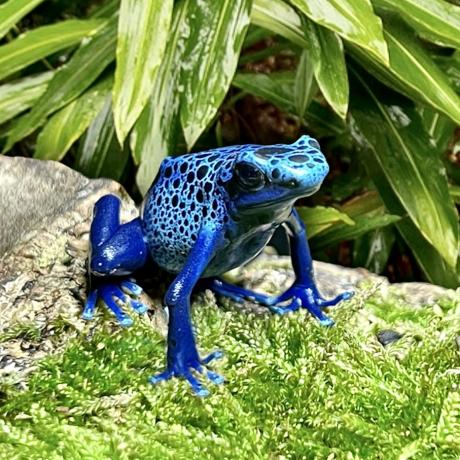

This is a large species of dart frog with adults reaching sizes of up to 5-6cm. Native to southern Suriname and is found in the Sipaliwini Savanna.
The Blue Dart Frogs or Azureus Dart Frogs as they are otherwise known, are predominantly blue in colour, bearing irregular patches of black. This two-tone colouration creates a spotted effect, with larger markings present across the dorsal and smaller spotting on the flanks. The sides of the face and legs are unspotted and often a darker blue compared to the rest of the body.
This is a large species of dart frog with adults reaching sizes of up to 5-6cm, they are angular in shape, have long forelimbs and a prominent sacrum. This gives the frog an almost hunched appearance.
This species is not sexable until at least 10-12 months of age. Usually females are the larger of the two sexes and become longer and wider. Males develop wider front toe pads and have a less defined back arch compared to that of females.
This species is native to southern Suriname and is found in the Sipaliwini Savanna. The natural habitat consists of savanna, creeks, rolling hills and primary forest. From wild observations, the frogs are found specifically in the localised forest islands around the Vier Gebroeders Mountain. They favour the thicker vegetation and are usually found close to the forest floor, among leaf litter and occasionally climbing trees.
These frogs are terrestrial, and the glass terrarium should have plenty of floor space. For two frog we recommend a minimum of 60 x 45 x 30cm (24 x 18 x 12”) though larger is always better - especially if you plan on keeping more than two. Sexed groups can cohabit and are best kept as pairs, or trios with one female to two males; as females can be aggressive, expressing dominant behaviour towards one another, in competition for males.
The Blue Poison Dart Frogs require ambient temperatures of around 22-26°C during the daytime when they are at their most active. At night time, temperatures can be as low as 18°C, to simulate the temperature drop which happens in the wild when the sun sets. Warming the air temperature by heating using a basking bulb works best, whereas heat mats provide surface temperature only and can quickly dry out the substrate. Any heat source used must be controlled by using a suitable thermostat, to ensure your frogs are maintained at the correct temperature.
It is vital to provide dart frogs with access to low level UVB lighting that sits within the parameters of Ferguson Zone 1, this helps them to produce vitamin D3 which is essential in the absorption of Calcium - keeping bones healthy and strong. This should be on for 12 hours during the day and turned off at night. If you intend is to grow live plants in the terrarium you must also provide suitable LED lighting for them to be able to thrive.
As these dart frogs are found mostly in primary forests which are notoriously humid, their natural humidity levels will fluctuate and can rise and fall between 70-90%. We recommend using treated tap water, bottled, or rain water as the chemicals in tap water can cause health problems for amphibians. Humidity levels can be achieved by using a spray bottle or mist system, which dampens the decor, foliage and substrate. Doing this both morning and evening helps maintain the right levels. This species won’t tolerate low humidity for long periods, especially if no other water source is available, the addition of a large shallow water dish will be readily enjoyed by the frogs. Some choose to build a waterfall within the terrarium, (making it a paludarium) which again, helps to maintain humidity without the need to mist as often.
For terrarium decor, these frogs thrive in a live planted bio-active terrarium, often using bromeliads to deposit their eggs in and rear tadpoles. The only limit with a natural terrarium is your imagination, we suggest looking at the natural habitat of these frogs and recreating a small piece of the rainforest in your own home!
Dense foliage provides natural enrichment and offers the frogs plenty of hiding places. Artificial plants are ideal for adding plenty of coverage in areas of the tank which look a little sparse, especially while live plants are getting established. Cork bark and vines also work well, adding to the natural look of any rainforest habitat. Adding in a drainage layer for bio-active setups, a soil based substrate to cover the floor and then a layer of leaf litter and moss on top can help to retain moisture.
Dart frogs may be small, but they have a huge appetite! They have a fast metabolism and will need feeding daily. They will primarily eat Fruit Flies(which can be cultured to maintain a constant supply) and hatchling crickets, these are nutritious and offer enrichment by way of encouraging natural hunting and foraging behaviours. They will also prey upon other small insects such as clean up crews such as Springtails and Isopods within the terrarium.
On all live feeds, it is important to use a good quality supplement powder to provide an essential calcium and vitamin boost to your dart frogs. The easiest method of application is to use a spare live food tub to dust the insects lightly in supplement. We advise dusting your insects on every feed, alternating between calcium and vitamin powders according to manufacturers recommendations.
Did you know... Poison Dart Frogs are NOT poisonous in captivity! They are so named because of their toxins being used by natives to lace the tips of darts for hunting. Their natural diet consists of ants, millipedes and mites which are extremely high in alkaloids; these toxins are accumulated in the skin of the frog. The captive diet of poison dart frogs lacks any alkaloids, meaning they pose NO risk to humans.